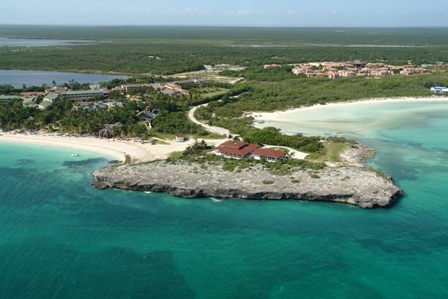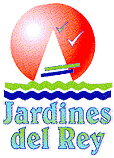 |
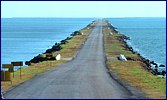 |
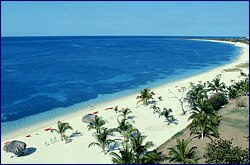
Jardines del rey
Dubbed the “Cuban keys”, the tiny islands of Jardines del Rey (“the King’s Gardens”) strung off Cuba’s Atlantic coast are immortalized in Ernest Hemingway’s novel, “Islands in the Stream”. Mangroves and everglades, flamingoes and roseate spoonbills, sun-bleached sand and turquoise waters make this little corner of paradise the perfect retreat.
The keys are in the agricultural province of Ciego de Avila, whose red clay soil is the most productive in the country. The provincial capital of the same name is surrounded by pineapple farms, and has the area’s main airport. Today, a 27-kilometre causeway connects the mainland to the keys, which are rapidly becoming one of the Caribbean’s most popular spots. The islands are part of Cuba’s northern coral reef, which yields spectacular snorkeling and diving.
| Places to visit |

![]() Cayo Coco
Cayo Coco
(Covered by thickets of mangroves, palms and other forestation, has a 22-kilometre strip of beach. A variety of excellent resorts—from the comfortable to the luxurious—line the beach. The island is named after the white ibis (coco).
![]() Cayo Guillermo
Cayo Guillermo
To the west of Cayo Coco boasts the highest sand dune in the Caribbean (15 metres). Ernest Hemingway spent a great deal of time camping, fishing and boating on this key during World War II. He is remembered for his double daiquiris, his boat (the Pilar) and his fishing tales. Resorts and spectacular beaches abound on Cayo Guillermo as well.
![]() Turiguanó
Turiguanó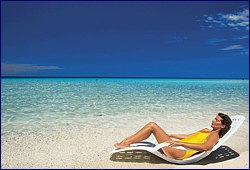
Island is dedicated to raising St. Gertrude’s cattle. Residents live in a tiny, Dutch-style village.
![]() Laguna de la Leche
Laguna de la Leche
(Milky Lagoon), south of Turiguanó, is coloured by sodium carbonate deposits. It is Cuba's largest natural reservoir.
![]() La Redonda
La Redonda
A lagoon east of Turiguanó, is the site of the international black bass fishing tournament every year.
![]() La Trocha
La Trocha
A military route built in the 19th century and partly restored, stretches for 68 kilometres with its fortifications, barbed wire and an ancient railway.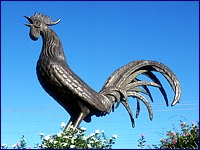
![]() Morón
Morón
The City of the Rooster, is a favourite tourist spot for visitors to the Jardines del Rey resort area. The town’s mascot, a cock that crows on the hour, is sculpted in bronze.
| EXCURSIONS: |
![]() CIEGO DE AVILA PROVINCE
CIEGO DE AVILA PROVINCE
Ciego de Avila province is Cuba’s fruit bowl, with its rich soil and plentiful water yielding enviable crops of citrus fruits, bananas and pineapples. Its traditions and culture, influenced by Spanish, Haitian and Jamaican immigrants, give Ciego de Avila a unique identity. Offshore, its tiny islands and keys constitute a tourist treasure, thanks to a causeway linking the mainland to Cayo Coco and Cayo Guillermo.
![]() CAYO COCO & CAYO GUILLERMO
CAYO COCO & CAYO GUILLERMO
Made famous by Ernest Hemingway’s “Islands in the Stream” and “The Old Man and the Sea”, Cayo Guillermo and Cayo Coco remain the ecological paradise he wrote about in these novels.
These two keys are part of the Sabana-Camaguey Archipelago. Cayo Coco is one of the largest, with 22 kilometres of sandy beach. Las Colouradas, another key in the archipelago, provides a perfect backdrop for water sports such as windsurfing, sailing, snorkeling and fishing. La Jaula and Los Flamencos beaches are considered the best in the keys with some five kilometres of breathtaking coastline.
Cayo Guillermo’s five kilometres of beach eagerly await visitors wanting to commune with nature. They can fish where Hemingway fished, and see his boat docked at its namesake beach, Pilar. They can doze under the Royal palms, snorkel, swim and sunbathe.
![]() CIEGO DE AVILA CITY
CIEGO DE AVILA CITY
The character of the provincial capital is defined largely by its architecture: unique portals, arches, roof tiles and neoclassical columns. Independence Avenue is the heart of the city, where diversions include the Principal Theatre, House of Culture, “Raùl Martinez” Art Gallery, Josè Marti Park and San Eugenio de Palma church – named after the city’s patron saint. Both Ciego de Avila and Moron played key roles during the wars of independence.
![]() MORON
MORON
You know you’ve arrived at Moròn when you see the bronze statue of a rooster perched at the city’s entrance. Other distinctive features of this town include Casa de la Trova, a place to enjoy local music and the train station with its unusual architecture. For archeology buffs, the Moròn Museum and the one-kilometre road to Jùcaro—declared a World heritage Site by UNESCO—are important experiences.
![]() TURIGUANO ISLAND
TURIGUANO ISLAND
This 18,000-hectare island, once cut off from the mainland by streams and channels, is now connected by a 23-kilometre road that provides easy access to this cattle-raising area. The island’s adorable town is modeled after a Dutch village.
![]() REDONDA LAKE
REDONDA LAKE
Occupying an area of four square kilometres, Redonda is a favorite place for large-mouth bass fishermen. The average weight of the bass caught here is seven pounds, but some 1,500 largemouth bass weighing more than 10 pounds each have been caught here. The lake gained fame in the early 1980s when a group of American fishermen caught 5,078 bass in five days. Competitive sports fishermen consider Redonda an ideal lake in which to try for personal, national and international records.
![]() LA LECHE LAGOON
LA LECHE LAGOON
Between Turiguanò and the coast near the city of Moròn lies La Leche (milk) Lagoon, where sodium carbonate deposits turn the water milky white. The lake is a refuge for flamingoes, snooks and tarpons. It is also a popular fishing spot, and is often used for sailing regattas.
![]() AGUACHALES DE FALLA
AGUACHALES DE FALLA
One of the few swampy areas on the northern coast is in Ciego de Avila, home of the Aguachales de Falla Hunt Club—and several species of ducks. The area is a system of seven lakes and dozens of ponds, connected by a web of streams and channels.
![]() COLONIAL TRINIDAD
COLONIAL TRINIDAD
Relive ancient history in this breathtaking colonial city. Visit the Iznaga Tower, La Canchanchara bar, a cigar factory and pottery shop. Lunch in the area.
![]() DAY TRIP TO HAVANA
DAY TRIP TO HAVANA
A short flight gets you into Havana for a tour through the old and modern city. Visit museums and shops; stop for lunch.
![]() SWIM WITH THE DOLPHINS
SWIM WITH THE DOLPHINS
Fly into Holguin, take a quick tour of the city, then ride to the aquarium at Naranjo Bay. There, sea lions and dolphins put on an exuberant show—and the dolphins will take you for a swim. Lunch at the aquarium’s seafood restaurant.
![]() MORON AND AREA
MORON AND AREA
This action-packed trip takes you on a boat tour of La Redonda lake and includes a snack at the Bass Fishing Centre restaurant. A horse-drawn carriage takes you through Moròn. The day concludes with cocktails at the Palmares cafeteria and a visit to “Dutch” town on Turiguano island.
![]() ECO-SAFARI
ECO-SAFARI
A jeep will take you from your resort to La Redonda Lake for a boat tour. You’ll visit a crocodile breeding farm, travel to the top of Cunagua Hill and go horseback riding. Lunch is included.
![]() AROUND THE ARCHIPELAGO
AROUND THE ARCHIPELAGO
Travel by bus to Cayo Paredòn Grande lighthouse and “La Guira”. Leisure time and lunch at Flamenco Beach. Boat ride through the southern coast of Cayo Guillermo. Visit to Pilar Beach. Open bar aboard the bus.
![]() CAYO COCO BY MOPED
CAYO COCO BY MOPED
A moped ride along a winding path gets you up close and personal with the flora and fauna of this Cuban paradise. A drink is included.
![]() CUBAN NIGHT AT THE JABALI CAVE
CUBAN NIGHT AT THE JABALI CAVE
Enjoy a special night in a brightly decorated cave. Your evening includes a show, disco and four cocktails.
![]() SEAFARI
SEAFARI
Sail over the second largest coral reef in the world. Includes snorkeling, fishing and lunch on board.
![]() DEEP SEA FISHING AND BASS FISHING
DEEP SEA FISHING AND BASS FISHING
A daily excursion that includes transfers, boat and fishing gear. For bass fishing, a fully experienced guide is provided.
 29.24°C
29.24°C



